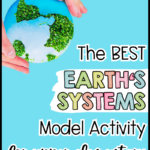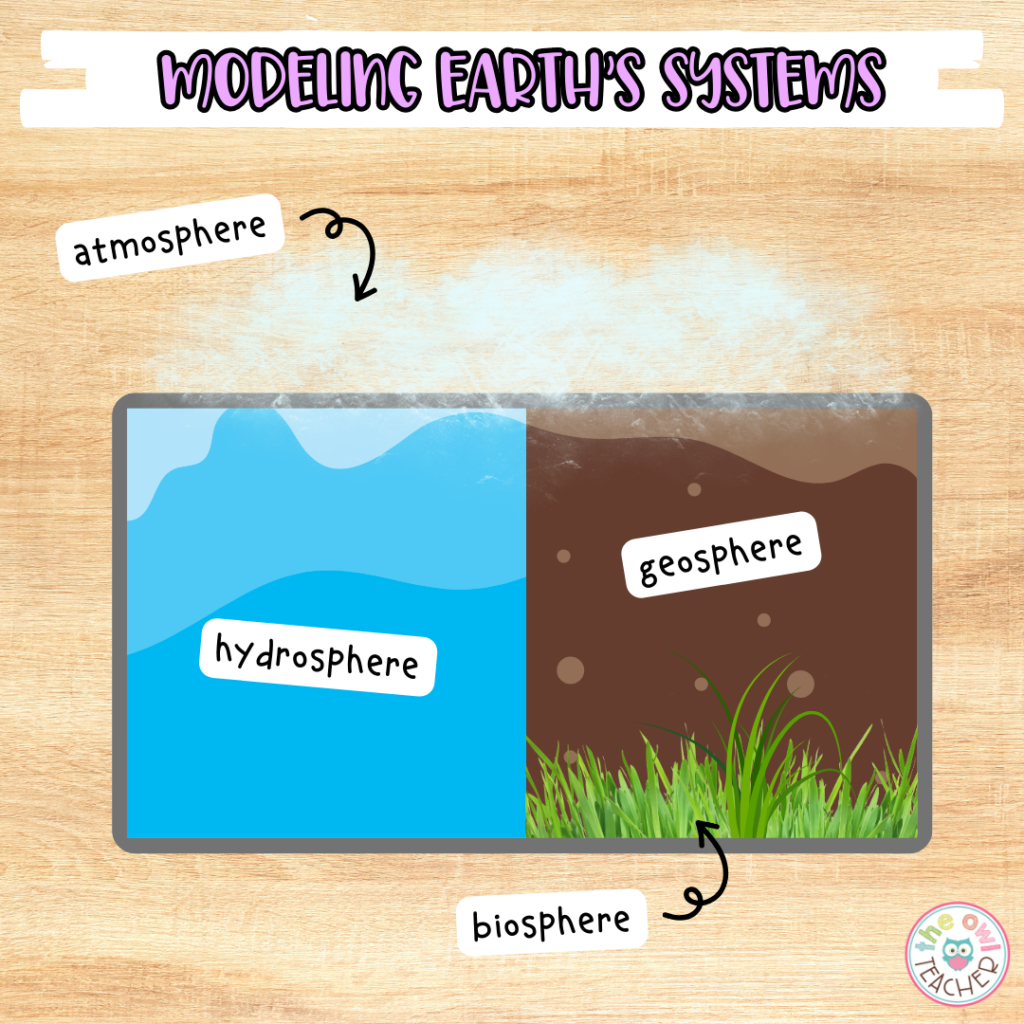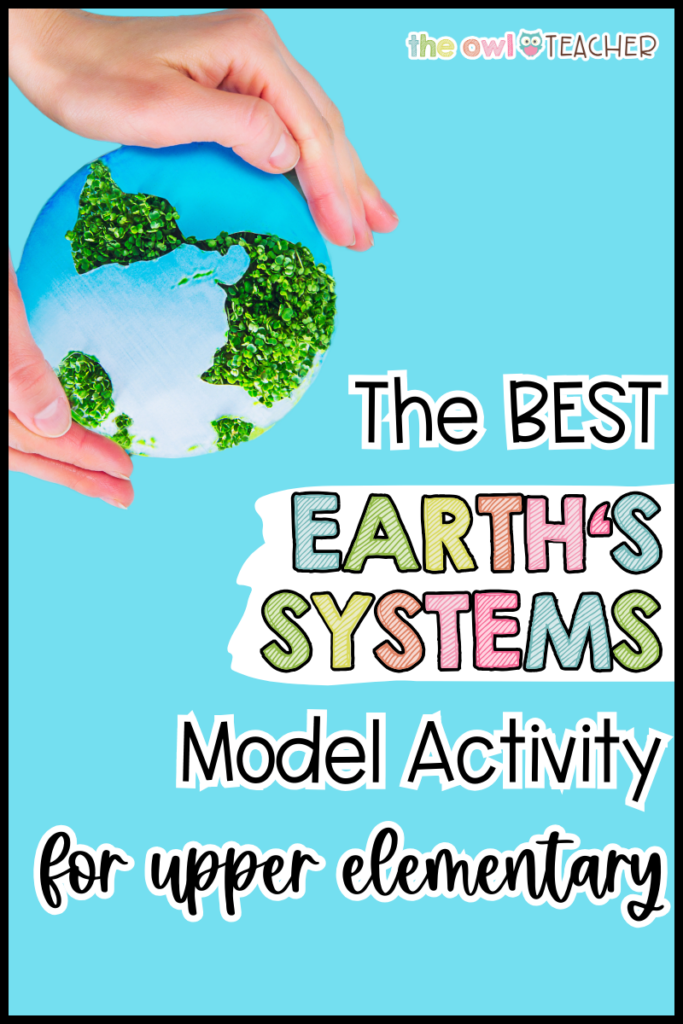
I know, I know—it’s a bit pretentious, isn’t it? To claim that this is the best Earth’s systems modeling activity you’ll ever use in your classroom?
Well, trust me… I’m just that confident that it’ll fulfill NGSS 5-ESS2-1 so well that you won’t have to look anywhere else!
Okay, so what exactly are we talking about, here? Today, I bring to you one Earth’s systems activity that checks all the boxes: it’s engaging, it’s hands-on, it’s relevant to the NGSS, and best of all, it’s a conduit for LEARNING. 🎉
For this activity, students will create a model of the Earth’s systems as well as explore each -sphere’s purpose and their interactions. It’s pretty nifty! Don’t worry about time, either—this activity shouldn’t take more than twenty minutes.
First, though, let’s take a sec to outline the requirements of NGSS 5-ESS2-1, then we’ll take a quick detour over to defining each of the Earth’s systems. After that, it’s all activity time! Let’s dive in!
Fulfilling 5-ESS2-1
In the Next Generation Science Standards, 5-ESS2-1 is relatively straightforward at first glance: “develop a model using an example to describe the ways the geosphere, biosphere, hydrosphere, and/or atmosphere interact.” So… It sounds like we need to just throw together a model of the Earth and its four systems! Great!
… But how do we do that in a way that will engage your upper elementary science students as well as providing them with ample opportunity to thoroughly explore the interactions between these systems? To get there, let’s first check out each system.
Breaking Down Earth’s Systems
First, the geosphere! The geosphere is the solid part of the Earth. This includes soil, sand, rocks, and minerals; basically, everything that makes up the Earth’s core, mantle, and crust. The main function of the geosphere is to shape the Earth and support life—that is, the biosphere! By housing landforms and supporting ecosystems, the geosphere also provides natural resources and even helps regulate Earth’s climate. That’s kind of important, right? 😉
Next in Earth’s systems is the biosphere. With a bit of critical thinking, I’m sure your students can make an educated guess on what the biosphere holds! From bacteria to trees to human beings like you and me, the biosphere includes all living creatures as well as their habitats and ecosystems. The purpose of the biosphere, of course, is to support life on Earth. As a result, the biosphere also helps provide important resources like food and medicine.
Then, there’s the hydrosphere. If the geosphere is the solid part of the Earth, then the hydrosphere is all the liquid parts! The hydrosphere is composed of all of the water on the Earth’s surface, including its oceans, lakes, rivers, groundwater, and even glaciers. Within the hydrosphere, water distribution is a huge component of Earth’s systems and forms the core of NGSS 5-ESS2-2. The hydrosphere also regulates the water cycle, which is vital to the survival of all living creatures within the biosphere, as well as supporting a number of ecosystems and natural resources. I guess you could say that the hydrosphere keeps life going swimmingly!
Finally, there’s the atmosphere to round out Earth’s systems. Your kiddos have likely heard the word “atmosphere” before, but it doesn’t hurt to provide a refresher! The atmosphere is the layer of gases surrounding the Earth that are held in place by gravity. These gases contain the air we breathe—a nice nitrogen/oxygen mixture—as well as a few other substances like water vapor. The atmosphere is super important for keeping our climate and weather stable, and it even helps filter out harsh UV light from the Sun. In addition, the atmosphere works like a greenhouse to trap warmth—without the atmosphere, the Earth would be as cold as the moon. That’s -243° Fahrenheit!
Okay—that’s enough technical terms and definitions. I’m sure by this point, your students are itching to get to the hands-on fun, so let’s jump right in!
The Ultimate Earth’s Systems Model Activity
The Goal
First things first: let’s outline our goal. To align with NGSS in this activity, students will develop a model of Earth’s systems using generic, everyday materials. This model will feature the Earth’s four systems: the geosphere, the biosphere, the hydrosphere, and the atmosphere, as well as their interactions.
… That looks good to me! If you’re satisfied with that goal, then let’s dive in! First, we’ll need materials. But even more first, quickly decide whether you’ll have students create individual models, or if they’ll be working in groups, as that affects how many materials you need.
If students are working in groups, then I recommend making larger models not only for visibility purposes, but also so that students have more space to work with and, of course, more room for everyone to participate. After all, it’s much easier to have five pairs of hands working with a large plastic tub than with a small foil tray.
The Materials
Okay—materials! For groups, you can go with an 8- or 13-liter large plastic tub like these, one for each set of students. Otherwise, another great (but smaller) option is foil pans! You can generally find a good supply of foil pans at the dollar store for cheap. You’re looking for something like this—that is, rectangular and not TOO deep, but deep enough to hold water without splashing everywhere. Trust me… You want the higher edges.
Once you have enough tubs or trays for your setup, you’ll also want to collect materials for each one of Earth’s systems. Here’s what I recommend for each system:
- Geosphere:
- Sand/soil (enough to line one side of each tub/tray)
- Small rocks and pebbles (think decorative aquarium pieces!)
- Biosphere:
- Plastic toy animals or figures (you can usually find a pack of small toy dinosaurs or other animals at a dollar store)
- Fake grass or other fake plants (also in the aquarium aisle! Very convenient!), like those used in my erosion activity
- Hydrosphere:
- Water (enough to line one side of each tub/tray)
- Atmosphere:
- Spray bottles (these can be small—you just need one for each group or several for students to share)
It seems like a big list, but most of these materials are the usual staple items that populate science cupboards on a regular basis. Oh, and it may be a good idea to invest in a few paper towels. Science is messy!
The Procedure
Now, let’s head into the procedure. First things first: explain the goal of the activity to your students. Consider phrasing the goal as a question or several questions in order to encourage student-led inquiry. If kiddos have a goal to work toward or a question to answer, they’re more likely to engage with the activity and put on their critical thinking caps!
Next, divide students up into groups (if you choose) and provide them with their plastic tubs or their foil trays if they’re working solo. These tubs/trays will serve as their canvases for representing Earth’s systems!
Here’s where you can choose your own adventure. Will you instruct students in creating their models as they go, or will you simply provide kiddos with the materials and see them off in the right direction? It’s totally up to you! You know your classroom best. Some students are more comfortable taking charge than others, so they may benefit from a student-led approach while others may need a bit more guidance.
Regardless, let’s go over the intended course of action for this Earth’s systems model. First, students will add sand or soil to one side of their tubs (or trays) to represent the geosphere. Encourage students to recall what, exactly, the geosphere is—the solid part of Earth’s surface that is made up of rocks, minerals, and soil.
Next, pour water (carefully, please) into the other side of the tub or tray to represent the hydrosphere. Remember that the hydrosphere is composed of all of the Earth’s water, including oceans, lakes, rivers, and groundwater.
Then, encourage students to brainstorm ways to show the atmosphere in their model. Obviously, there’s already air above the geosphere and the hydrosphere—there’s air everywhere! But how else can they represent the atmosphere? What else makes up the atmosphere besides oxygen?
Students should reach the conclusion that the atmosphere is a layer of gases surrounding Earth. This should hopefully spur them to reach for the spray bottle! Use the spray bottle to mist water into the air above the tubs/trays, representing the atmosphere and its mingling substances. Recall, too, that the atmosphere has a huge effect on weather and climate, which affects all of Earth’s systems in turn.
Finally, it’s time to set up the biosphere—“plant” the fake grass in the soil! With this touch, all four of Earth’s systems are represented, but there’s more to do. Now it’s time to flesh out the purpose of the systems.
First, add rocks and pebbles to the geosphere and create various landforms, like mountains or valleys. Encourage students to talk through their thought process here. What do these landforms do? How does the geosphere affect the other -spheres of Earth’s systems? One way is through the creation of volcanoes, which can greatly affect the atmosphere.
Next, populate the biosphere with plastic toy animals or figurines. Where do these life forms go? What do they need? How do they affect the geosphere or even the hydrosphere?

The Review
Once students are satisfied with their models, encourage them to observe and discuss the interactions between Earth’s systems. Offer thought-provoking questions! Here’s a short list to get you started:
- How does water from the hydrosphere flow into the geosphere? How does it affect the biosphere? How does it get into the atmosphere?
- How do plants in the biosphere interact with the atmosphere? How does the geosphere provide plants with what they need, including water from the hydrosphere?
- How might animals from the biosphere interact with the geosphere?
To accentuate the questions, allow students to manipulate their models of Earth’s systems, adding or removing pieces to demonstrate different Earth processes. Ultimately, you’ll want to reconvene to host a class-wide discussion to reflect on the activity and how it compares to Earth’s systems in the real world. Encourage students to make connections between the model and their understanding of the subject.
And… That’s it! Congratulations! You and your upper elementary science students have just completed the ultimate Earth’s systems activity. The learning doesn’t have to stop there, though—encourage your kiddos to pay special attention to Earth’s systems on their way home for the day. You could even give them an assignment: observe and record three interactions between Earth’s systems after school!
… Or maybe skip the homework if you’re feeling nice. 😉
Ultimately, by fulfilling NGSS 5-ESS2-1, you’ve brought Earth’s systems to life right in your classroom. Through setting up and exploring this hands-on modeling activity, your kiddos have developed a deeper understanding of Earth’s systems and, most importantly, the purposes and interactions that shape our planet and, you know, give us life! That’s pretty important!
Now that your students know just about everything there is to know about Earth’s systems, well, you know what time it is. That’s right: time to check for understanding! If you’re like me and you prefer to check for understanding via informal assessments, then you’re in luck—I’ve got twenty-six informal assessment ideas right this way. There’s one for each letter of the alphabet!
Alternatively, if you’re looking for some fun review games after this engaging activity, my Earth’s Systems Science Vocabulary Games are a great way to go! These interactive games are the perfect way to reinforce the important science concepts, and they also serve as superb science centers if you don’t have tons of time on your hands (and, let’s be real, who does?).
Keeping students engaged during the more technical side of Earth science can be challenging, but thankfully, there are plenty of intriguing activities you can implement in your upper elementary science classroom to keep their attention. With this Earth’s systems model, you get fun AND learning—the best of both worlds. Go forth and teach!
Oh, but first… Sign up for my email list! It’s super quick, easy, and rewarding. You’ll get hand-picked blog posts and resources centered around a weekly math and science theme sent straight to your inbox—talk about easy lesson planning! Check it out below the break!

















